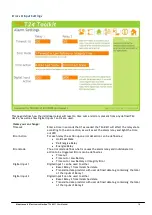
Mantracourt Electronics Limited
T24-RM1 User Manual
2
Introduction / Overview
The T24-RM1 offers dual power relays capable of mains power switching. These relays can be configured as
high, low or window alarms and can be associated with a group of up to 8 T24 acquisition modules per relay.
Relays can operate when the sum of the assigned acquisition modules reach a setpoint or when any of the
modules reach the setpoint. There is also a mode where the difference between the lowest and highest value is
compared to the setpoint. This is ideal for applications where you are looking for a group of weights to be
within a certain band. i.e. balancing four corners of a weigh scale or a hanging truss.
Relays can be latched and a digital input or external command can be used to reset them.
An alarm/error signal relay is operated if communication is lost or other selectable errors occur and this alarm
resets once the source of the alarm or error is removed.
This module is supplied in an IP65 sealed ABS case but a DIN rail option is available.
The state of the power relays during an error can be selected.
Communications Overview
The T24 range of telemetry devices each have a factory set unique
ID
.
Data is shared between devices using
Data Provider
messages. A device generates these messages which can
then be used by many other devices simultaneously.
These messages ( or packets ) of information contain a single value of data and each is identified by a
Data
Tag
.
The
Data Tag
should
be unique for each message.
ID
Identifies each device
Each device has a unique
ID
that is factory set. This is represented as a 6 character hexadecimal
number consisting of the digits 0 to 9 and the letters A to F.
I.e.
FFD3BE
Data Tag
Identifies each Data Provider message
A
Data Tag
consists of a 4 character hexadecimal number consisting of the digits 0 to 9 and the
letters A to F. The
Data Tag
can be changed by the user but the factory default is to match the
last 4 characters of the device
ID
.
I.e. An acquisition device of
ID
FFC12B
would have a default
Data Tag
of
C12B
.
When a device consumes data (i.e. a handheld displaying data from an acquisition device) all it is doing is
listening to all of the
Data Provider
messages and selecting the one it wants to use. It then extracts the data
and displays it.
Some devices that use
Data Provider
messages also need to know the
ID
of the device providing the data. This
is necessary if that device needs to specifically wake the data providing device as opposed to using a broadcast
wake that will wake all devices on the same channel and using the same encryption key.
Pairing offers an automated method of hooking a provider and consumer of data together. However, some
devices may require you to manually enter
Data Tag
and
ID
information so it would be beneficial to the user to
understand the above mechanism.
Configuration Overview
You need to determine the Data Tags of all acquisition modules that are to contribute data to this relay
module.
Each relay can use the value of up to 8 inputs which are, depending on the mode selected, used to generate a
value that is checked against your setpoint.
The toolkit allows you to see the calculated value of the selected set of Data Tags. In the case of ‘sum’ mode
this will help in determining whether you want to apply an offset. This may be useful to effectively ‘zero’ the
input total to make calculating the setpoints easier.




































